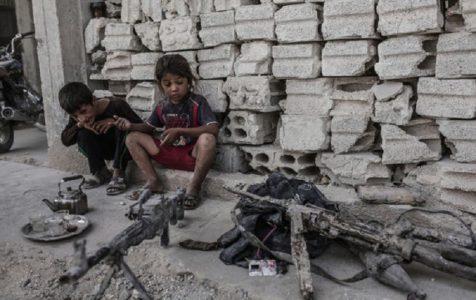
Islamic State terrorists use hundreds of brainwashed children as fighters
While children who have been through war typically draw devastating pictures of the violence they have suffered, few show themselves as the perpetrators.
The suicide belts, car bombs and other explosives sketched again and again by a 14-year-old boy newly arrived at this camp in northern Iraq are the ones he built himself: used by Islamic State militants against civilians and troops in Iraq and Syria.
One image depicted him killing a man with a spray of bullets, something he said he did during three years as a child fighter forcibly conscripted by Islamic State.
Kidnapped from his Yazidi homeland in northern Iraq, he said he got used to the sound of bombs falling on Islamic State’s de facto capital, Raqqa, in Syria, as security forces closed in last year.
“Here’s where I got shot fighting the SDF,” said the boy, not named to protect him from retribution, referring to the US-backed rebel Syrian Defense Forces and pointing out a bullet wound on his shin.
Giving him time to draw and talk about his experience is part of a treatment program to help him move on and protect both him and others from lasting damage.
Hundreds of children are estimated to have been used as fighters by Islamic State, including boys who joined with their families or were given up by them and the offspring of foreign fighters groomed from birth to perpetuate its ideology.
Experts have warned that indoctrinated children, who began escaping the clutches of Islamic State as its territory fractured last year, could pose an ongoing threat to security, both regionally and in the West, if they are not rehabilitated.
Treating Yazidi children, who were separated from their families and in many cases orphaned, holds particular challenges.
There is little in the way of specialized care for them in Iraq, where the minimum age of criminal responsibility is nine. The government has detained and prosecuted dozens of children for their suspected IS affiliation, according to a recent report by New York-based Human Rights Watch.
Naif Jardo Qassim, a psychotherapist treating children at Rawanga refugee camp near Dohuk emphasized that they are “victims and not criminals,” and should be treated as such.
Highlighting the scale of the task, Yazidi teacher Hoshyar Khodeida Suleiman recounts the story of one of his students, a young boy reunited with his family in the autumn.
A few days later, the boy’s father woke up in the middle of the night to find his son wielding a knife to his throat, confused about whether he should kill his parents or himself.
“He was screaming that they were infidels and that he would rather die than be one of them,” Suleiman said.
When the militants overran Yazidi towns and villages in 2014, it killed or enslaved more than 9,000 adults and children in what the United Nations has called a genocidal campaign against a religious minority labeled heretic by Islamic State.
It sold girls and women into slavery, marrying some off to fighters, and trained many boys to join the ranks of what it called the Cubs of the Caliphate, posting videos of them committing atrocities in the name of its self-declared state.
Most of the children returned, not home, but to displacement camps in northern Iraq, where they live with relatives – their parents either missing or killed by the militants.
“Everything changed while they were gone,” said Qassim. “That’s if they even remember anything from their lives before.”
Adding to that instability is the weight of the traumas they have endured.
Source: Albawaba





